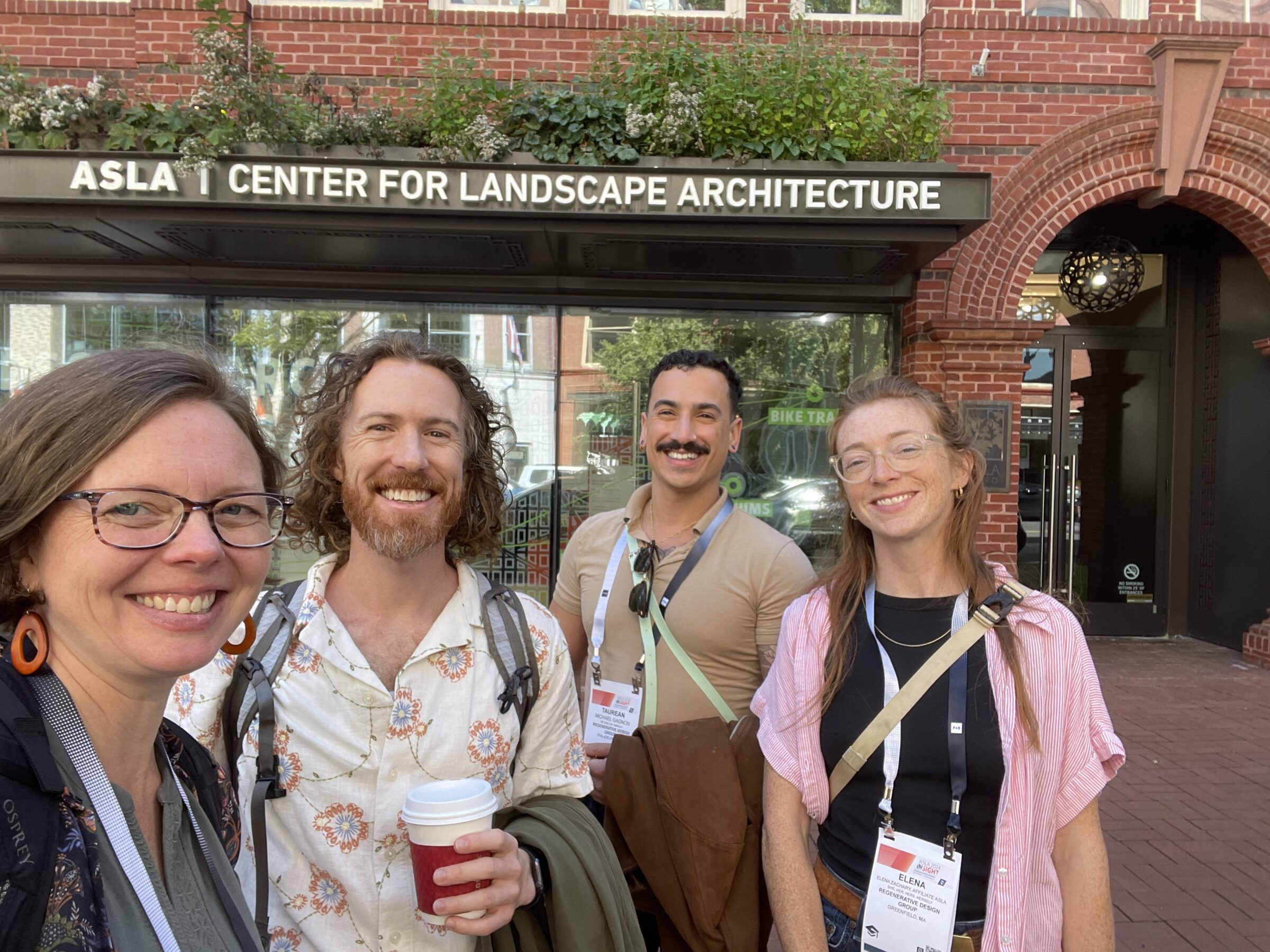
RDG at ASLA Conference 2024: Illuminating the Future of Landscape Design
In October, Regenerative Design Group (RDG) team members Rachel Lindsay, Taurean Gagnon, and Elena Zachary attended The American Society of Landscape Architects (ASLA) Annual Conference. This year’s gathering, themed InSight: Honoring our Past, Illuminating the Future, was held in Washington, D.C., and celebrated ASLA’s 125-year legacy while presenting exciting and innovative ideas for the future of landscape architecture and design.
The event was a chance to engage with colleagues and collaborators, exchange ideas, and explore new tools and strategies to address pressing environmental and social challenges. Rachel also co-presented “Unlocking the Carbon Potential of Soils,” drawing a large and engaged audience of landscape architects and designers eager to deepen their understanding of soil carbon sequestration.
Unlocking the Carbon Potential of Soils
 Rachel, alongside Chris Ng-Hardy (Sasaki) and Gillian Davies (BSC Group), co-presented the session “Unlocking the Carbon Potential of Soils.” The presentation underscored the pivotal role of soil organic carbon (SOC), which accounts for 80% of terrestrial carbon stocks, in mitigating climate change. Rachel, Chris, and Gillian explored innovative strategies for enhancing soil carbon storage, including biochar amendments, designing soil profiles that reflect regional ecosystems, and adopting low-impact construction practices. They also highlighted the risks of SOC loss during development and offered tools like early soil testing and soil preservation plans to minimize disruptions.
Rachel, alongside Chris Ng-Hardy (Sasaki) and Gillian Davies (BSC Group), co-presented the session “Unlocking the Carbon Potential of Soils.” The presentation underscored the pivotal role of soil organic carbon (SOC), which accounts for 80% of terrestrial carbon stocks, in mitigating climate change. Rachel, Chris, and Gillian explored innovative strategies for enhancing soil carbon storage, including biochar amendments, designing soil profiles that reflect regional ecosystems, and adopting low-impact construction practices. They also highlighted the risks of SOC loss during development and offered tools like early soil testing and soil preservation plans to minimize disruptions.
These and other strategies are central to the Massachusetts Healthy Soils Guide, a comprehensive resource aimed at equipping practitioners with strategies and best practices to conserve, restore, and maximize the carbon storage potential of soils in design and construction projects. This guide, currently being developed by a collaborative team including Regenerative Design Group, Sasaki, BSC Group, Linnean Solutions, A.D. Makepeace, and Read Custom Soils, was recently highlighted in an article by the Greenfield Recorder, showcasing its potential impact on sustainable design practices.
Attendees left inspired to integrate carbon-conscious approaches into their work, strengthening the collective effort to address climate challenges through thoughtful, site-specific design.
Restoring to What?
Rachel and Elena attended the session “Restoring to What?”, which explored how three different firms approach ecological restoration projects and tackle difficult questions about design direction, criteria, and monitoring.
Presenters Jennifer Dowdell (BioHabitats), Claudia West (Phyto Studio), and Martha Eberle (Andropogon) redefined ecological restoration not as a return to past ecosystems but as creating a stable base that can thrive without continuous human intervention. They emphasized climate migration corridors, rebuilding ecological abundance, and balancing design appeal with functionality.
Another standout moment for Rachel was Dr. Lyla June Johnston’s keynote, which included inspiring examples of indigenous land management practices, such as Northeast chestnut tree propagation and West Coast clam gardens.

Taurean attended a wide range of sessions, from “Sound and the City” to “The Complex Nature of Mini-Forests” and “New Tools for Managing Urban Biodiversity.” Particularly impactful were sessions on equitable design, such as “Shifting Ground: Homelessness and the Fight for Equitable and Compassionate Design” and “Transcending Anglo/American Olmstedian Design to Create Culturally Responsive Spaces.” These discussions highlighted the role of landscape architecture and design in addressing social justice issues.
Key Takeaways
Rachel deeply appreciated the openness and honesty displayed by the speakers and presentations at ASLA 2024. Reflecting on the event, she noted, “There’s a culture of respect and understanding that encourages designers and landscape architects to share both their successes and failures in tackling the complex social and environmental goals.” This culture of transparency is essential for advancing the field and building collaborative relationships. By openly discussing obstacles and setbacks, we can collectively learn, adapt, and refine the tools and strategies needed to design resilient landscapes that not only withstand but actively mitigate the impacts of climate change.
The conference also underscored the importance of diversity—in plant systems, design approaches, and professional perspectives to create resilient, equitable landscapes.
ASLA 2024 served as a powerful reminder of the impact landscape architects and designers can have in shaping a sustainable and inclusive future. Rachel’s presentation on soil carbon and the team’s experiences throughout the conference highlighted the growing momentum behind regenerative practices and the need for collaboration and innovation. We look forward to continuing the conversation with our new connections as we work together toward a more resilient world.



Comments (0)